Manfrotto XPRO Geared Head review
-
-
Written by Gordon Laing
In depth
The Manfrotto MHXPRO-3WG, or XPRO Geared Head for short, is three-way geared tripod head, designed for precision adjustments. Announced in March 2015, it’s Manfrotto’s smallest, lightest and most affordable geared head to date, coming-in below the earlier Junior 410 and the heavyweight 405 and 400 models. As such it’s ideally-suited for use with lighter systems like mirrorless cameras, but can equally accommodate most DSLRs fitted with a decent macro lens.
Geared heads are considered specialist in the tripod world, and their precision adjustments are most commonly exploited in macro, studio, astro, architectural and other technical photographic styles. But once tried, many photographers adopt them for more general use, enjoying their considered control over the often hap-hazard nature of a conventional ball head.
Most geared heads share the same three axes as a traditional three-way head, but employ gears with either knobs or handles to make the adjustments. A small turn of the knob makes it easy to make very fine adjustments or corrections to the composition, while clutches allow you to temporarily disengage the gear for more significant movements. In my review I’ll take a detailed look at the XPRO geared head and compare it to other geared options out there. I’ll be paying particular attention to how it compares with the Junior 410, previously the smallest and most affordable option in Manfrotto’s range and a head that I’ve personally owned for many years.
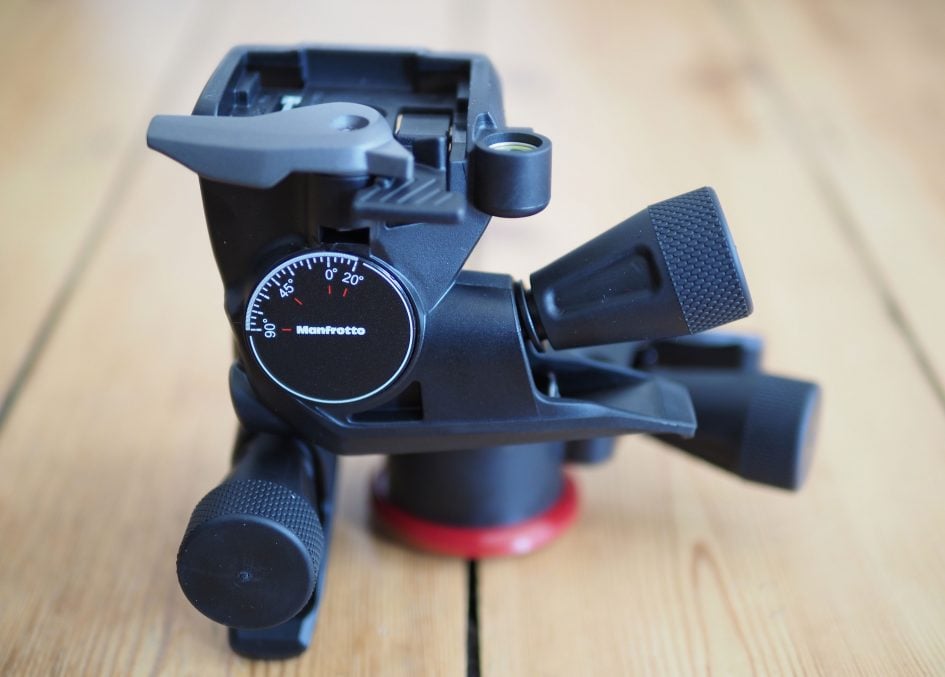
At the time of writing, Manfrotto offered four geared heads, designed for different loads and budgets. The smallest, lightest and most affordable – not to mention the most recent – is the XPRO geared head, reviewed here. It weighs 750g and handles a maximum load of 4kg. Next up in the series is the Junior 410, weighing 1220g and handling a maximum load of 5kg. After this comes the 405, weighing 1600g and handling a maximum load of 7.5kg. Finally there’s the 400, the literal heavyweight of the series, weighing-in at a considerable 3879g and accommodating loads up to 10kg. Depending on your region, the 400 may be hard to find new, but the other three should be readily available.
Here’s links to each one and as always, you can support my work when you shop (for anything!) using the links.
[geot][/geot][geot country=”US”]Buy the Manfrotto XPRO Geared Head from Amazon.com[/geot][geot region=”UK”]Buy the Manfrotto XPRO Geared Head from Amazon.co.uk[/geot][geot region=”Germany”]Buy the Manfrotto XPRO Geared Head from Amazon.de[/geot][geot region=”France”]Buy the Manfrotto XPRO Geared Head from Amazon.fr[/geot][geot region=”Spain”]Buy the Manfrotto XPRO Geared Head from Amazon.es[/geot][geot country=”Italy”]Buy the Manfrotto XPRO Geared Head from Amazon.it[/geot][geot country=”Canada”]Buy the Manfrotto XPRO Geared Head from Amazon.ca[/geot][geot exclude_region=”UK,Germany, France,Spain” exclude_country=”Italy,Canada,US”]Buy the Manfrotto XPRO Geared Head from eBay[/geot], B&H, or Adorama.
[geot][/geot][geot country=”US”]Buy the Manfrotto Junior 410 geared head from Amazon.com[/geot][geot region=”UK”]Buy the Manfrotto Junior 410 geared head from Amazon.co.uk[/geot][geot region=”Germany”]Buy the Manfrotto Junior 410 geared head from Amazon.de[/geot][geot region=”France”]Buy the Manfrotto Junior 410 Manfrotto Junior geared head from Amazon.fr[/geot][geot region=”Spain”]Buy the Manfrotto Junior 410 geared head from Amazon.es[/geot][geot country=”Italy”]Buy the Manfrotto Junior 410 geared head from Amazon.it[/geot][geot country=”Canada”]Buy the Manfrotto Junior 410 geared head from Amazon.ca[/geot][geot exclude_region=”UK,Germany, France,Spain” exclude_country=”Italy,Canada,US”]Buy the Manfrotto Junior 410 geared head from eBay[/geot], B&H, or Adorama.
[geot][/geot][geot country=”US”]Buy the Manfrotto 405 geared head from Amazon.com[/geot][geot region=”UK”]Buy the Manfrotto 405 geared head from Amazon.co.uk[/geot][geot region=”Germany”]Buy the Manfrotto 405 geared head from Amazon.de[/geot][geot region=”France”]Buy the Manfrotto 405 geared head from Amazon.fr[/geot][geot region=”Spain”]Buy the Manfrotto 405 geared head from Amazon.es[/geot][geot country=”Italy”]Buy the Manfrotto 405 geared head from Amazon.it[/geot][geot country=”Canada”]Buy the Manfrotto 405 geared head from Amazon.ca[/geot][geot exclude_region=”UK,Germany, France,Spain” exclude_country=”Italy,Canada,US”]Buy the Manfrotto 405 geared head from eBay[/geot], B&H, or Adorama.
[geot][/geot][geot country=”US”]Buy the Manfrotto 400 geared head from Amazon.com[/geot][geot region=”UK”]Buy the Manfrotto 400 geared head from Amazon.co.uk[/geot][geot region=”Germany”]Buy the Manfrotto 400 geared head from Amazon.de[/geot][geot region=”France”]Buy the Lumix TZ100 from Amazon.fr[/geot][geot region=”Spain”]Buy the Manfrotto 400 geared head from Amazon.es[/geot][geot country=”Italy”]Buy the Manfrotto 400 geared head from Amazon.it[/geot][geot country=”Canada”]Buy the Manfrotto 400 geared head from Amazon.ca[/geot][geot exclude_region=”UK,Germany, France,Spain” exclude_country=”Italy,Canada,US”]Buy the Manfrotto 400 geared head from eBay[/geot], B&H, or Adorama.
Buy the Arca Swiss D4 from B&H or Adorama.
The choice between them – like all tripod heads – is primarily influenced by the load you need to support. With a maximum load of 4kg, the XPRO should in theory be more than enough for pretty much any mirrorless system, not to mention most DSLRs even when fitted with a fairly hefty lens. But like the top theoretical speed on cars, the quoted maximum load of a tripod head is a guideline only and you should be shopping for something that’ll operate comfortably with your desired gear rather than at its limits.
With that in mind, the XPRO geared head is ideal for actual loads of around 2-3Kg which means it’ll still be adequate for any mirrorless camera, not to mention most entry-level to mid-range DSLRs, but if you’re intending to use a heavier body or a fairly hefty lens, then you should consider the Junior 410. Similarly if you’re shooting at very high magnification, whether with a large telephoto or in a macro environment, you’ll appreciate the greater stability of the larger heads in the series even if the body is modest. And finally if you’re shooting in the studio or with larger format cameras, you’ll again want to aim for the larger heads, especially as portability won’t be as big a concern.
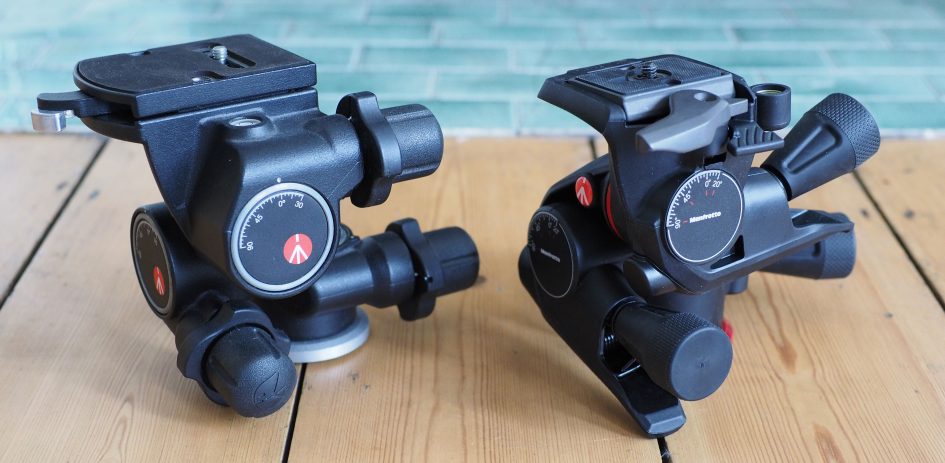
Above: Manfrotto 410 Junior (left) and XPRO (right) geared heads
As you’ll discover though, there’s much more to each head than simply its weight and maximum load. The quality and smoothness of the gearing varies, as do the types of clutches, the guides on offer, and even the mounting systems. But first an important note on the heft of the head itself and how it’ll work with your tripod legs.
Geared heads are typically taller and heavier than typical three-way, fluid or ball heads and as such even the smaller models can look and feel top-heavy perched on your tripod legs. My own Junior 410 head may have previously been the smallest and lightest in Manfrotto’s geared range, but I tend to leave it mounted on my largest 055 legs as it simply feels too big and top-heavy on smaller tripods, especially if they’re carbon fibre. After all, at over 1.2kg, the Junior 410 head alone is virtually the same weight as Manfrotto’s 190CXPRO3 legs; indeed it’s heavier than most of the camera and lens combinations I carry these days too which is why it invariably finds itself left at home or only brought out when I’m driving to a shoot. A shame since when I do take it out, I always fall back in love with the precise adjustments it offers.
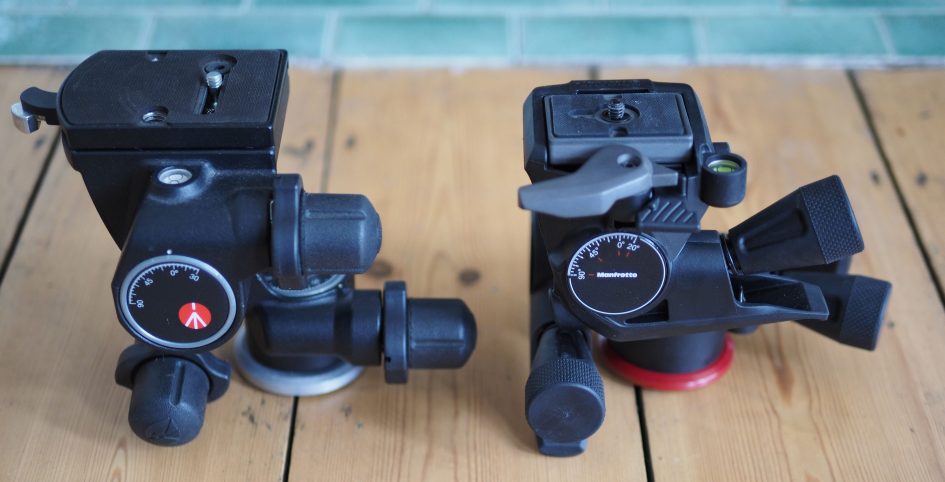
Above: Manfrotto 410 Junior (left) and XPRO (right) geared heads
At roughly half a kilogram less, the XPRO is noticeably lighter than the Junior 410. It’s a head I’m happy to carry around by hand and also use with more portable legs including my Gitzo Traveller (although obviously I won’t be folding the legs back over it for transportation as I can with a small Markins ball head). It’s physically a little smaller than a 410 too, but the significant difference is the weight.
The XPRO geared head is substantially lighter than the other models in the series due to its construction from ‘techno-polymer’ plastic versus aluminium. The XPRO build quality certainly feels very solid in your hands without any creaks or bends to worry about, but there’s no denying the aluminium construction of even the Junior 410 lends it a feeling of greater confidence. Is it actually tougher? I can’t say as I’ve not given the XPRO any rough treatment yet, but if both were dropped onto concrete, I would expect the 410 to handle the impact better. But again if you perch the 410 on legs that aren’t a good match, it is more likely to topple, so if you have lighter legs, the XPRO remains the preferred choice. As for the impact on performance, check out my comparison later in the review.
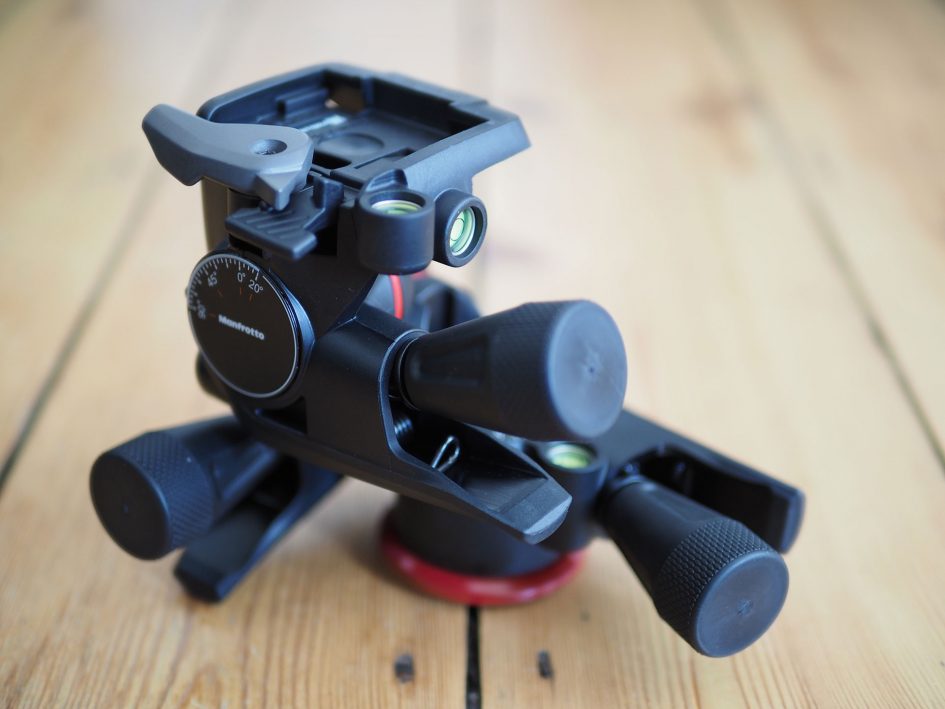
Moving onto the gearing, all four Manfrotto geared heads offer three axes of motion, but with slightly varying ranges. In terms of panoramic rotation at the base, all can be turned by 360 degrees. In terms of front tilt, all four will angle 90 degrees downwards, or 30 degrees upwards for all but the XPRO which offers a fractionally lower 20 degrees. Finally in terms of lateral tilt, the 410 and 405 again offer -90 to +30 degrees, and the XPRO -90 to +20 degrees; interestingly the largest 400 is the most limited in lateral tilt with a range of just +/-7.5 degrees.
Each employs different gearing, with the XPRO unsurprisingly being the coarsest: a full turn of a knob on each will result in 9.5 degrees of rotation on the XPRO, versus 7.2 degrees on the 410, 6.55 degrees on the 405, and 8.57 degrees on the 400. It’s therefore clear out of the four that the 405 will allow the finest adjustments followed closely by the 410, and this is borne-out when you compare them side-by-side. Later in the review you’ll see videos I filmed with the XPRO and 410 heads and the 2.3 degrees difference per turn of their respective knobs is quite apparent.
That said, I did find the knobs on the XPRO felt smoother than those on my Junior 410 which at times can feel quite stiff. This could be down to manufacturing variations and use though.
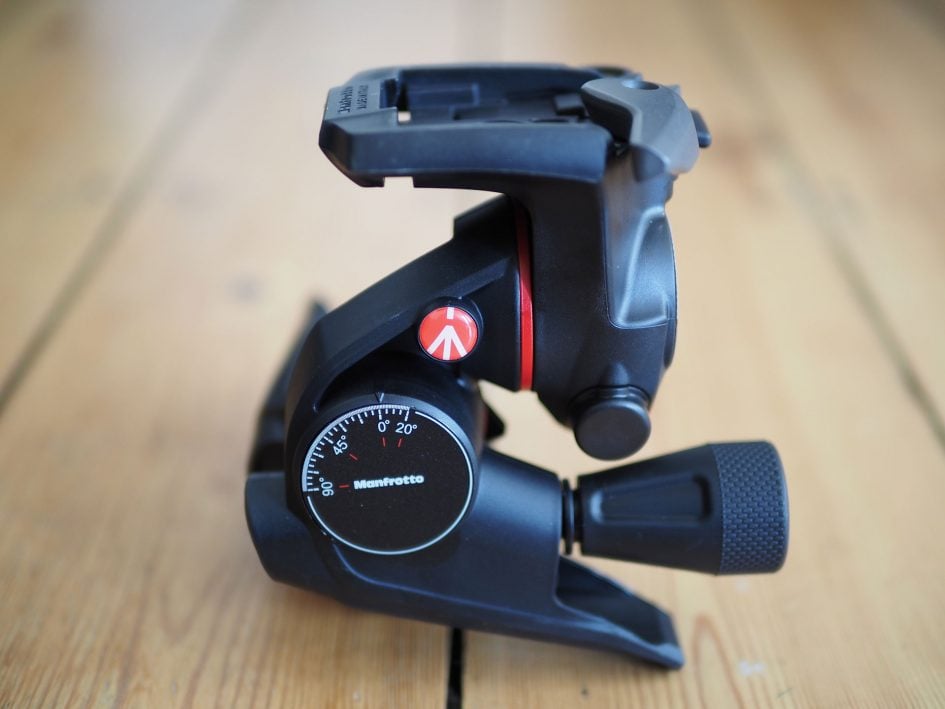
Each model offers a clutch system which temporarily disengages the worm from the gear, allowing you to make large changes in position quickly. Typically the worm is pushed against the gear with a spring, and the clutch system simply holds it back before springing back into place when you release it. On the XPRO head, each knob is connected directly to a worm, then hinged at the end. A spring holds it in place against the gear for normal use, but by squeezing the knob towards a plate, you can disengage it from the gear – in use this feels a little like squeezing the handles on those large crocodile clips used on car batteries.
The Junior 410 clutch is different: the worm and knob stay in position, but a handle around them is twisted to temporarily disengage the worm from the gear. I almost always twist this the wrong way at first, but it’s pretty obvious which way it needs to go once you have your hands on it.
When you release the clutches on any of the heads, the worm will need to mesh back with the gear and unless they’re perfectly lined-up, this will invariably involve the head lurching a little to the side. Occasionally the lurch only happens when you start twisting the knob again, so the trick is to always turn the gear knob a little after re-engaging. This is perfectly normal for all gear heads though, and I found both the XPRO and 410 could easily hold a load against the gear without backlash or wobble.
A quick note for those who are into frame blending, HDR or other situations where you need the position absolutely locked-down for repeatability. Most geared heads, including the ones I tested, are not always the best choice for bracketing work as they generally can’t be locked in position. Indeed, even with a spring pressing the worm against the gear, the nature of the mechanism means there can’t help but be a little play which in turn means the composition could fractionally change between shots. One exception is the reassuringly expensive Arca Swiss D4 which is a hybrid between a ball head an geared head, allowing you to lock individual axes as required, but at roughly four to five times the price of the XPRO, it’s not for the faint-hearted.
Moving-on, most geared heads include one or more bubble levels to help ensure your composition is absolutely straight. Interestingly while the Junior 410 has just one bubble near the plate clamp at the top of the head, the XPRO generously features three. There’s one on the base that joins with your tripod legs (possibly redundant since your legs will probably have one here too), and more usefully, two by the plate clamp for use in the landscape and portrait orientation. Having a separate bubble level for portrait shooting is a considerate addition and one that might make the XPRO more useful than the 410 to some shooters, although if you shoot with an L bracket it’s not important.
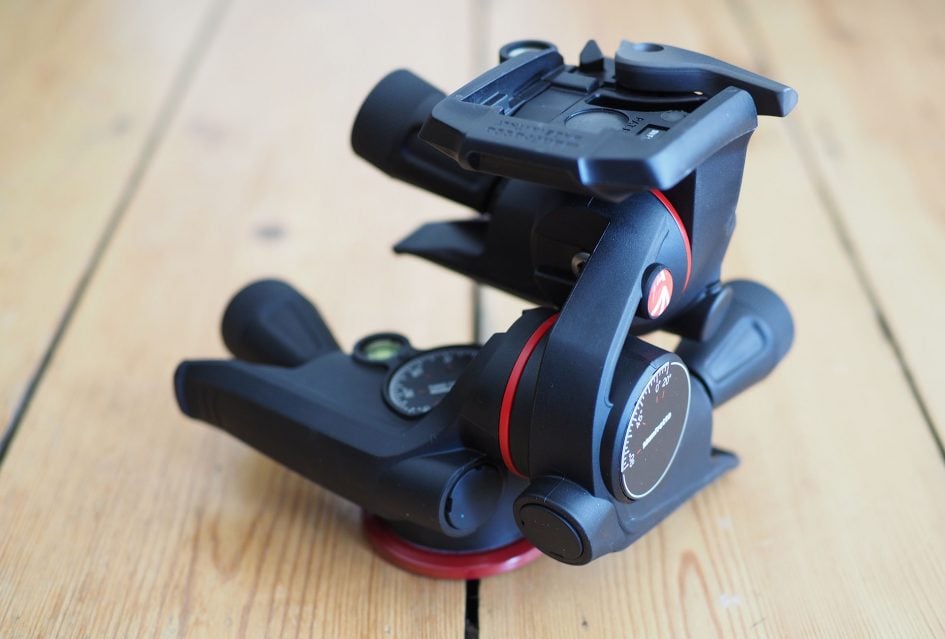
Speaking of plates and clamps, this is another area where the heads vary. The Manfrotto 405 and Junior 410 both use the 410PL plate, a fairly substantial affair with a large lever to release it. Meanwhile the XPRO employs Manfrotto’s smaller and almost ubiquitous 200PL-14 plate. I certainly prefer the folding handle on the 200PL plate compared to the twist knob on the 410PL as it’s easier to get a really tight fit – and if you lose it, you’ll find it easy to source a replacement – but to be honest what I’d like even more is a standard Arca Swiss dovetail. I realize there’s a lot more 200PL accessories out there, but once you start talking about geared heads, you’re dealing with a more specialized photographer who may already own Arca Swiss compatible plates and brackets for use with existing clamps. It wouldn’t be so bad if Manfrotto allowed you to easily change the clamp system, but on the XPRO it’s moulded in place. This for me is arguably the biggest annoyance as I don’t really want to be swapping plates or brackets when I change tripod heads. Of course the Arca Swiss D4 solves this problem, but I’m not willing to spend the price of a good body on a head. Not yet anyway.
Manfrotto XPRO vs 410 Junior geared head performance
To illustrate and compare the performance between the Manfrotto XPRO and 410 Junior geared heads in practice, I mounted them in turn to my Manfrotto 055CXPRO3 legs, and fitted a Sony A6000 with an FE 70-200mm zoom set to 200mm for a 300mm field-of-view; I used the zoom’s tripod foot to mount onto each plate for maximum stability. I then filmed a video clip on each head, adjusting each axis, demonstrating the clutch and re-engagement, and finally the damping of vibrations after a knock or an adjustment. Here are the two videos, first for the XPRO, then for the 410 Junior.
Above: Tests with Manfrotto XPRO geared head on 055CXPRO3 legs. Filmed with Sony A6000 and FE 70-200mm at 200mm (300mm equivalent).
Above: Tests with Manfrotto 410 Junior geared head on 055CXPRO3 legs. Filmed with Sony A6000 and FE 70-200mm at 200mm (300mm equivalent).
I think it’s clear from the two videos that the Junior 410 head allows smoother and finer / slower adjustments thanks to its gearing ratio, and that its more substantial construction soaks up the vibrations faster. It is unsurprisingly a superior head given its higher weight and price. But it’s also clear the XPRO is a very good performer. Yes it’s cheaper and lighter, but it still allows fine adjustments and while the damping isn’t quite as good as the 410, it’s more than adequate for most.
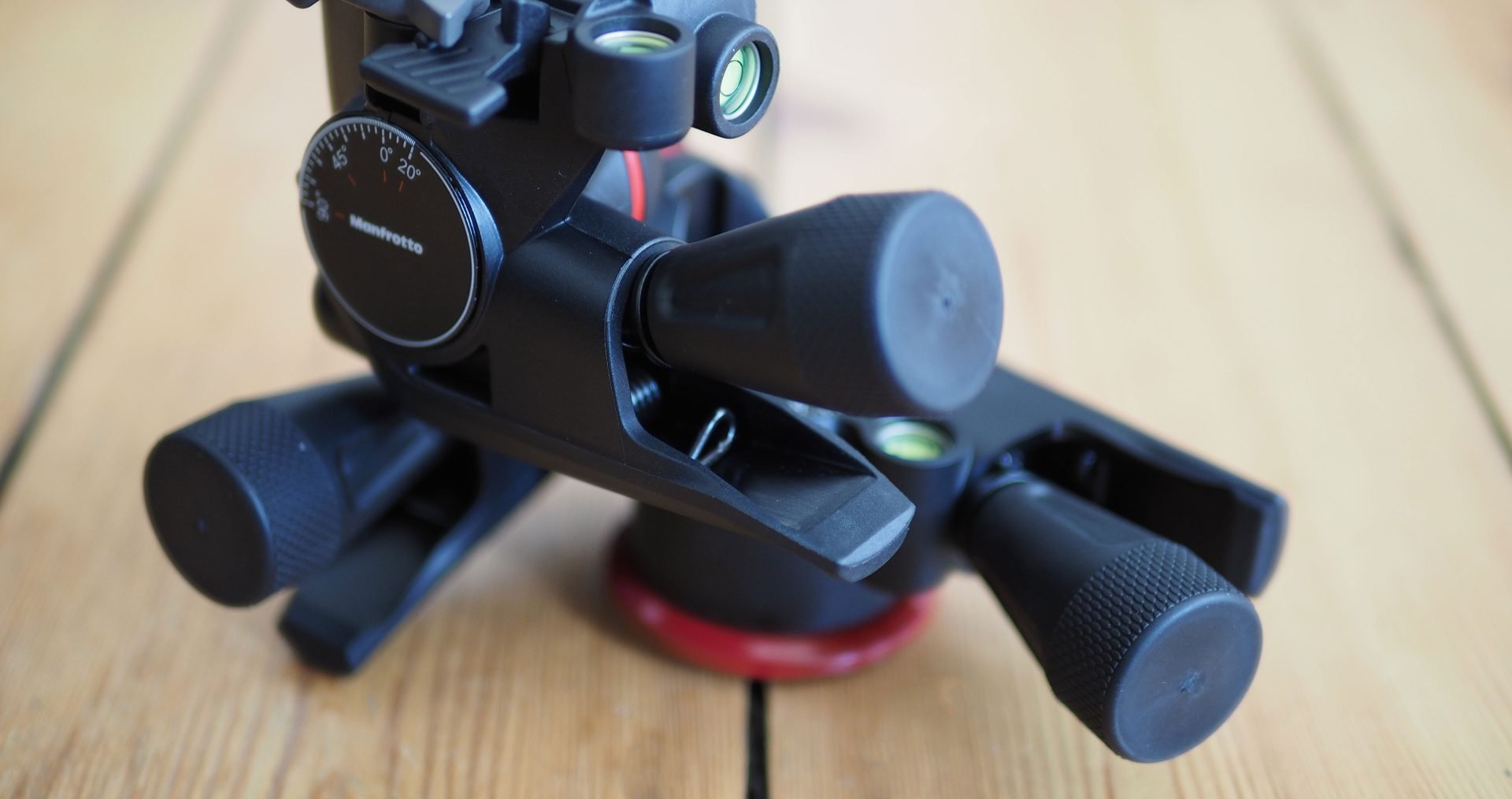
 The Manfrotto XPRO geared head is the lightest and most affordable option for those wanting to experience the joy of precision tripod photography. Like all geared heads, you can fine-tune your camera's position in three axes with a twist of the appropriate knobs, and while the gearing isn't as fine as more expensive models, it's good enough to position most systems. The maximum load of 4Kg will easily accommodate any mirrorless camera or mid-range DSLR with a decent lens in comfort. Like other geared heads, the ratio isn't designed for sweeping video pans, and anyone wanting absolute repeatability for bracketing work should look for a model with a lock; higher-end photographers will also miss an Arca dovetail or means to swap the clamp for one. But as an entry to geared-head photography, the XPRO is a triumph, offering the control beloved by macro, architectural, studio and other precision genres at an affordable price. Seasoned gear-head users might also pick one up for use with smaller legs and cameras, as it's one of the lightest options around.
The Manfrotto XPRO geared head is the lightest and most affordable option for those wanting to experience the joy of precision tripod photography. Like all geared heads, you can fine-tune your camera's position in three axes with a twist of the appropriate knobs, and while the gearing isn't as fine as more expensive models, it's good enough to position most systems. The maximum load of 4Kg will easily accommodate any mirrorless camera or mid-range DSLR with a decent lens in comfort. Like other geared heads, the ratio isn't designed for sweeping video pans, and anyone wanting absolute repeatability for bracketing work should look for a model with a lock; higher-end photographers will also miss an Arca dovetail or means to swap the clamp for one. But as an entry to geared-head photography, the XPRO is a triumph, offering the control beloved by macro, architectural, studio and other precision genres at an affordable price. Seasoned gear-head users might also pick one up for use with smaller legs and cameras, as it's one of the lightest options around.


